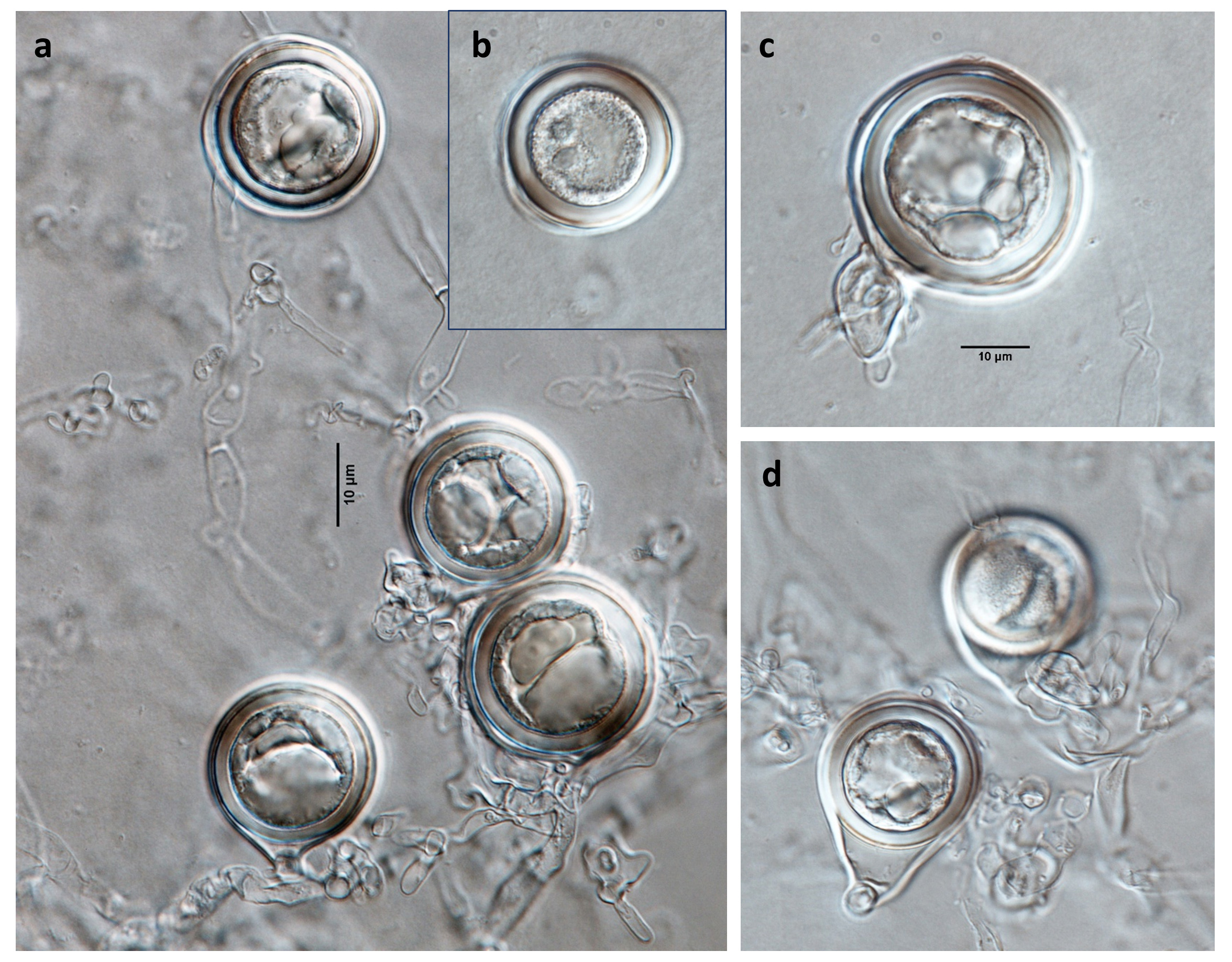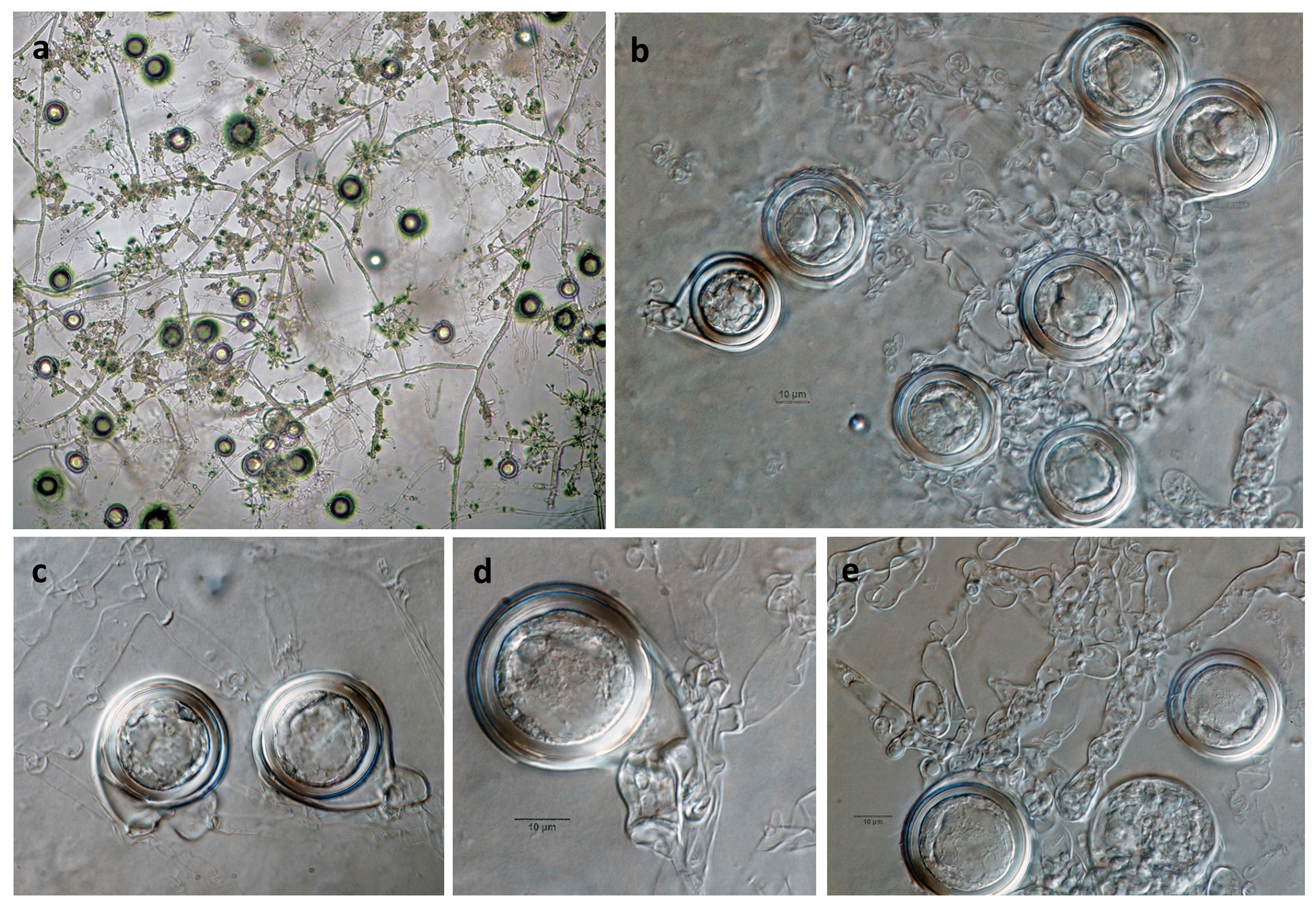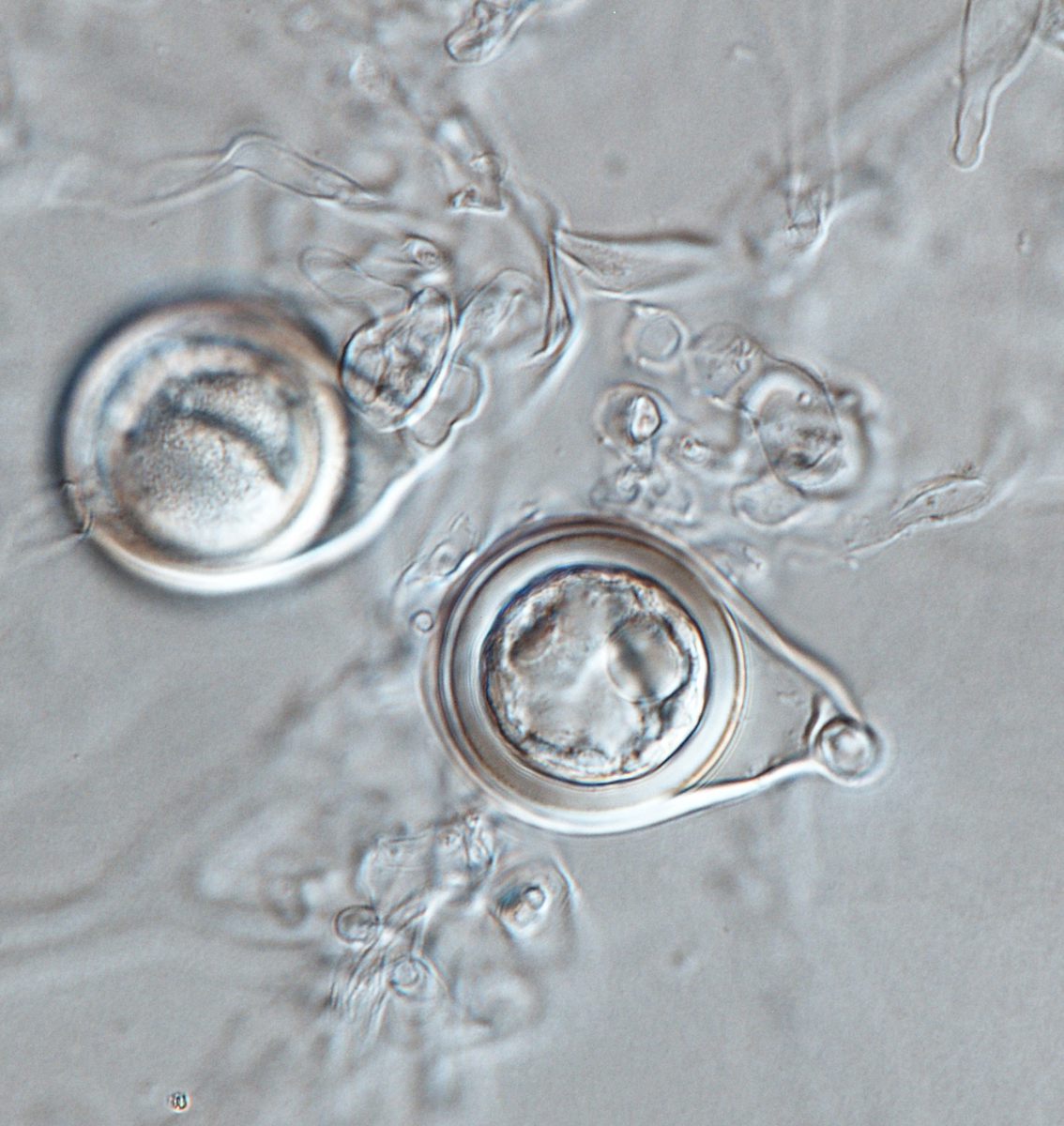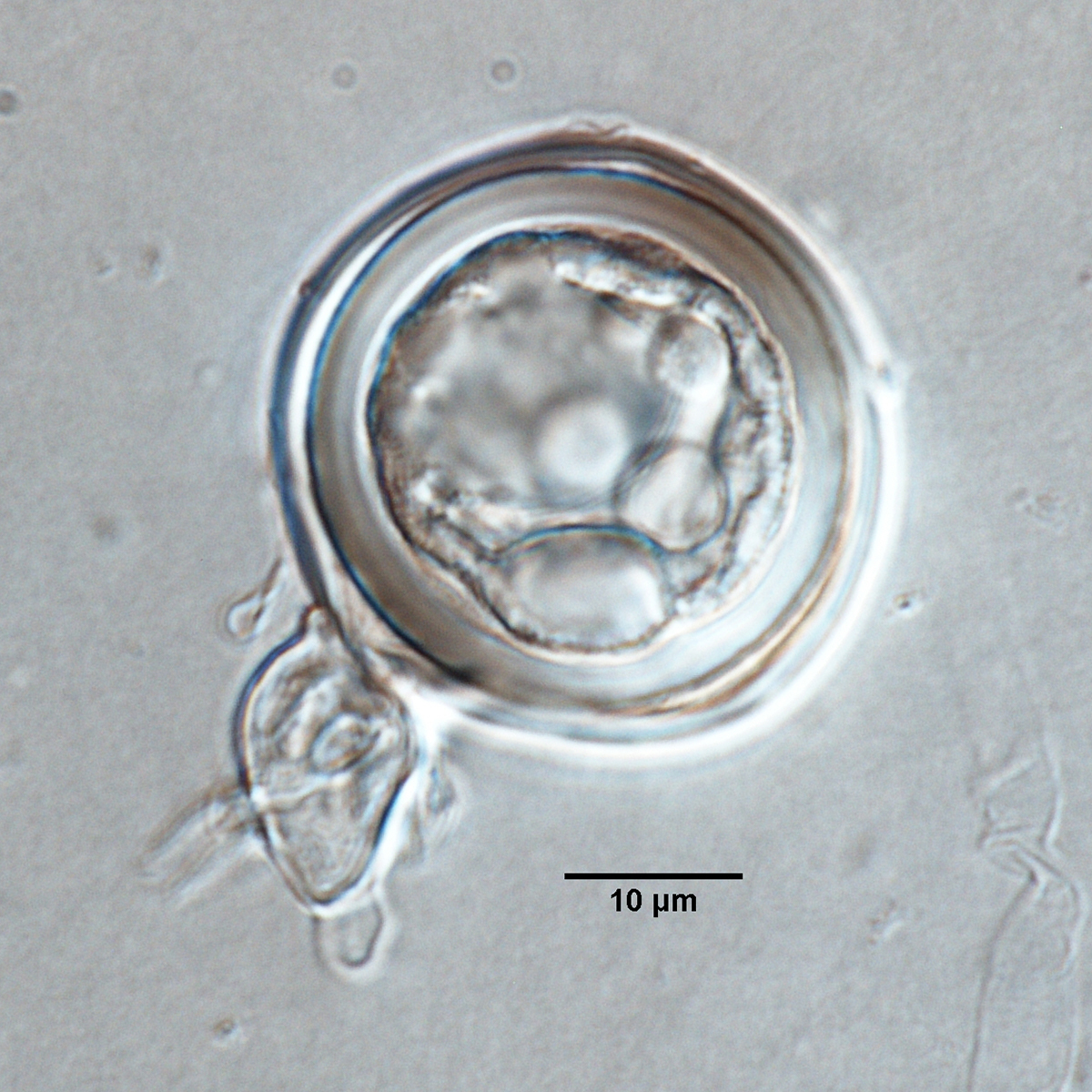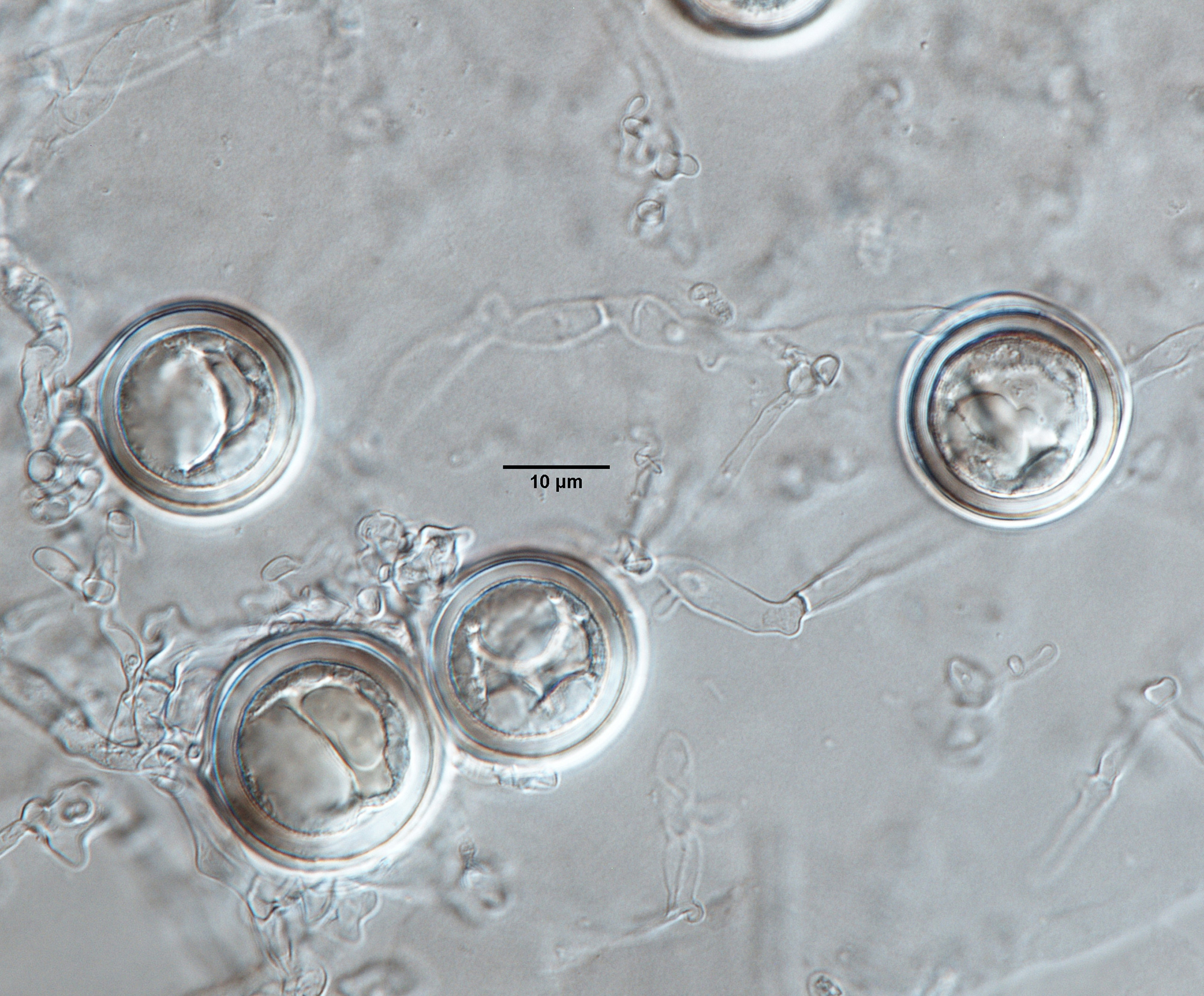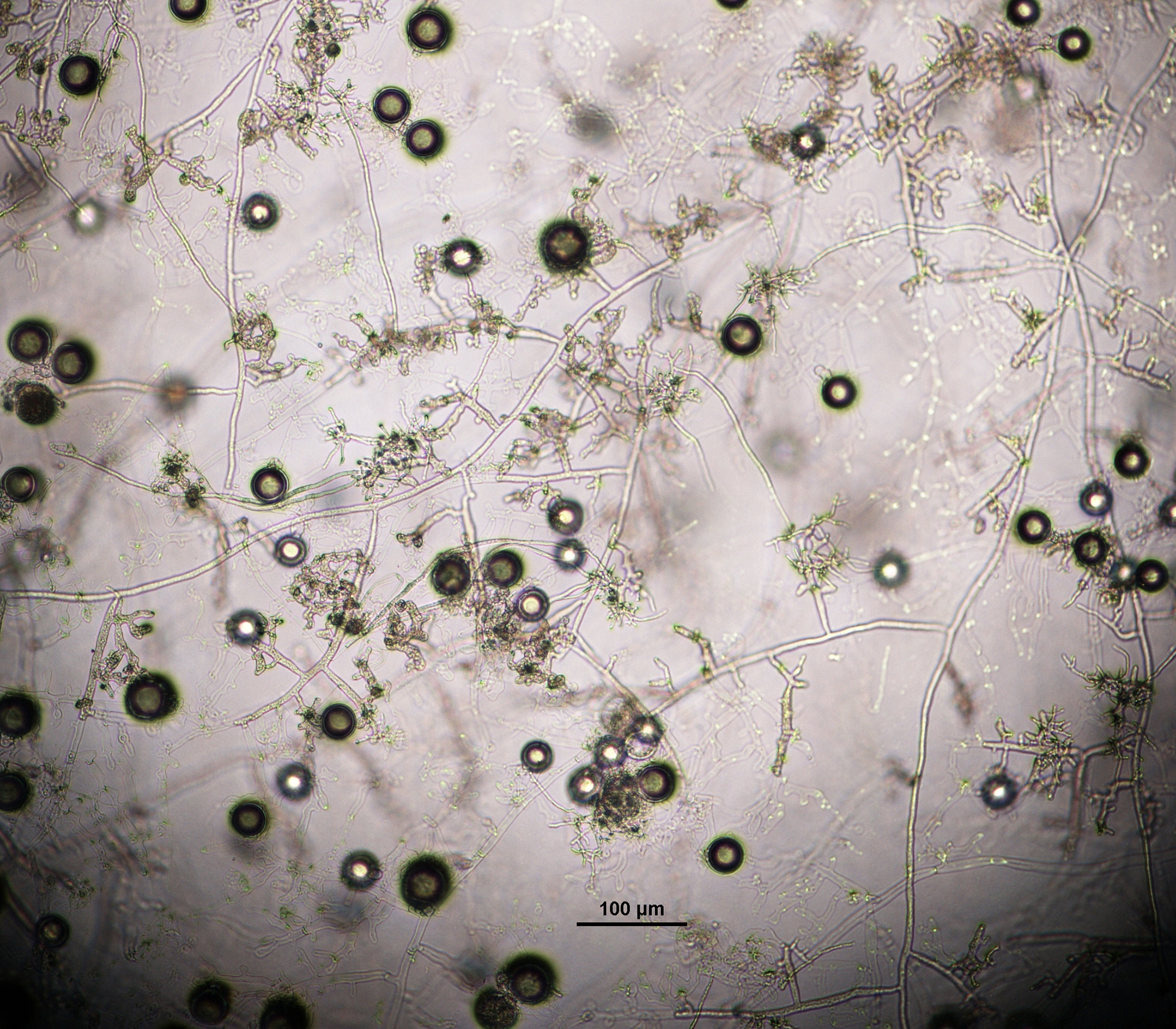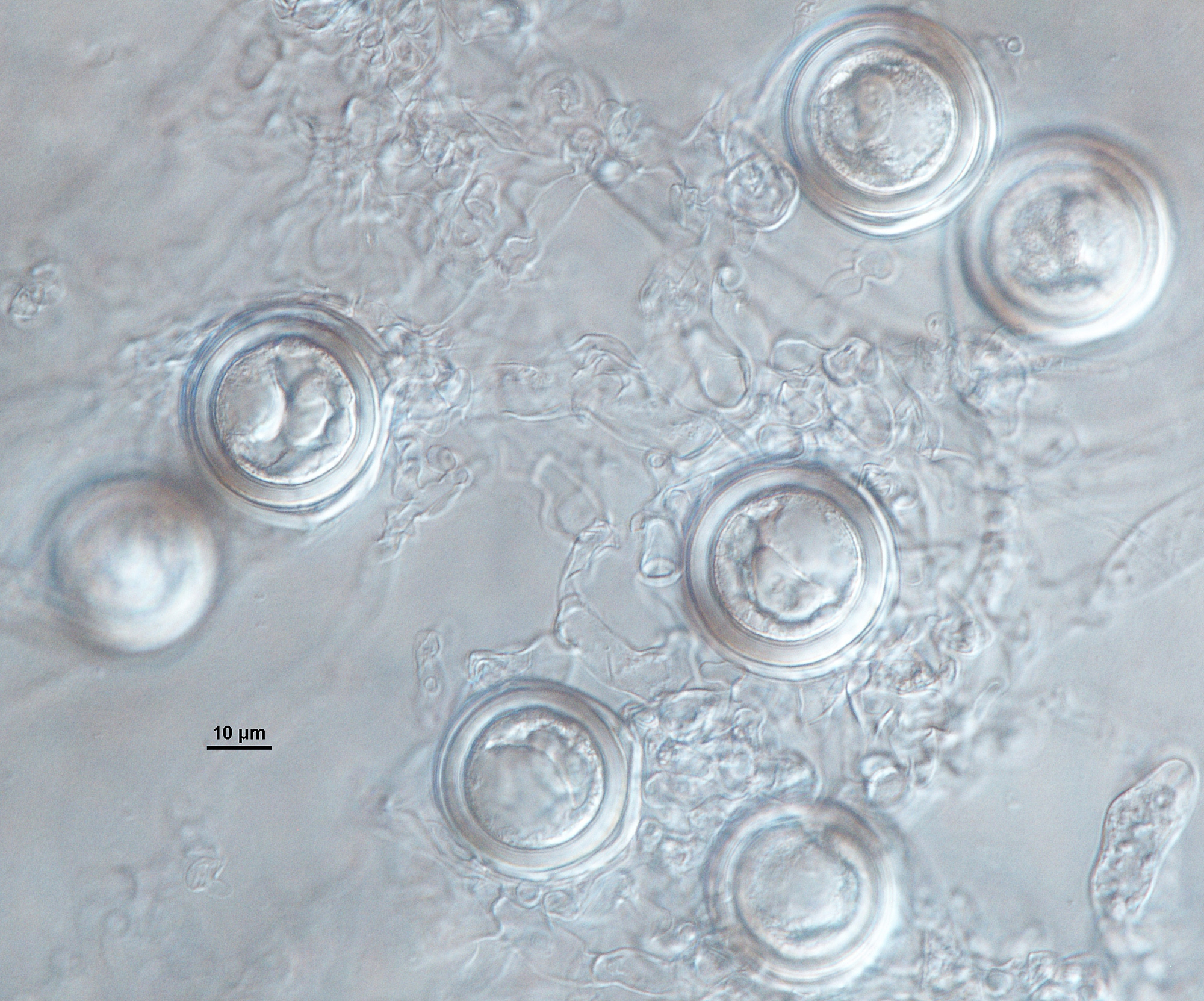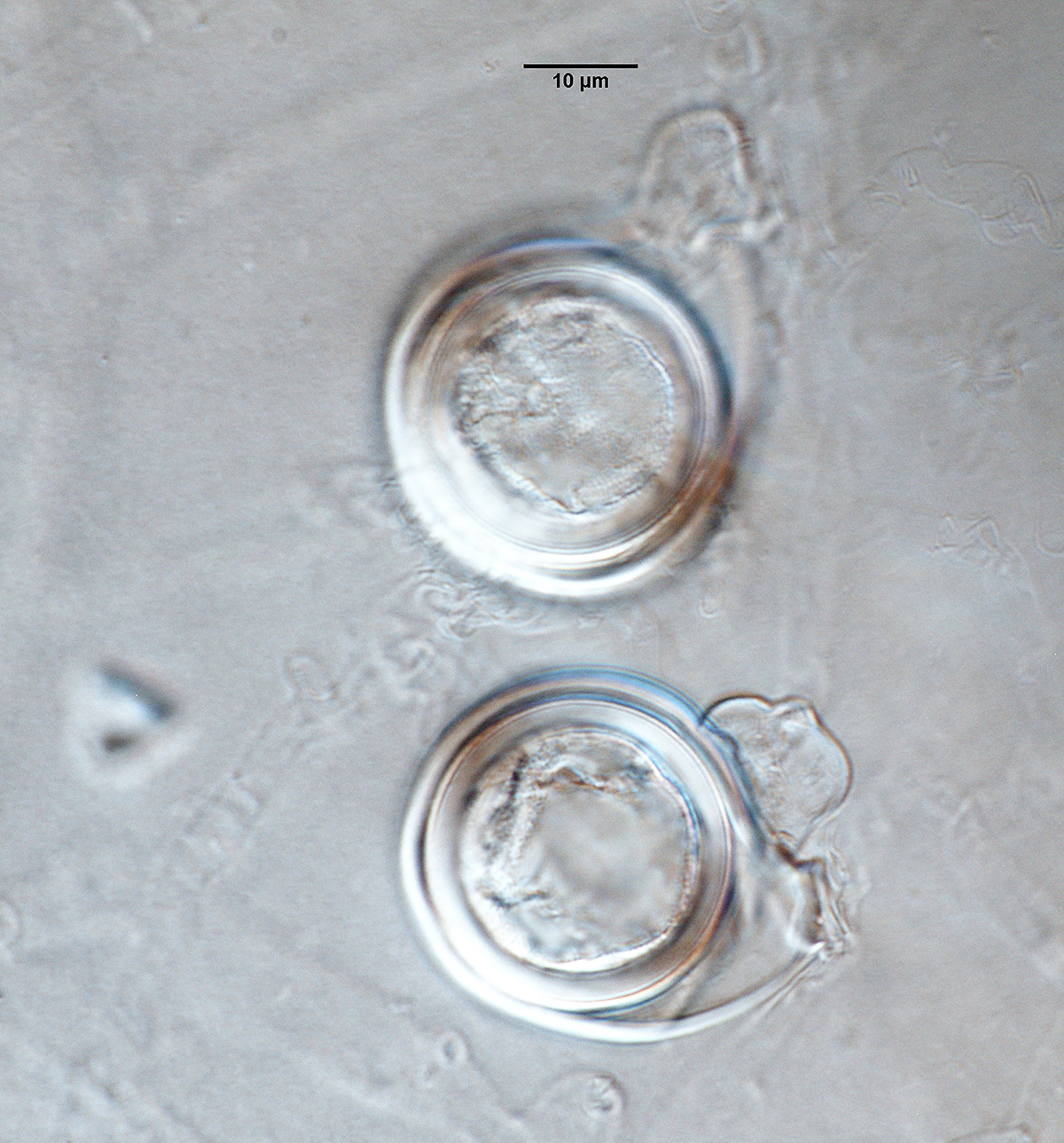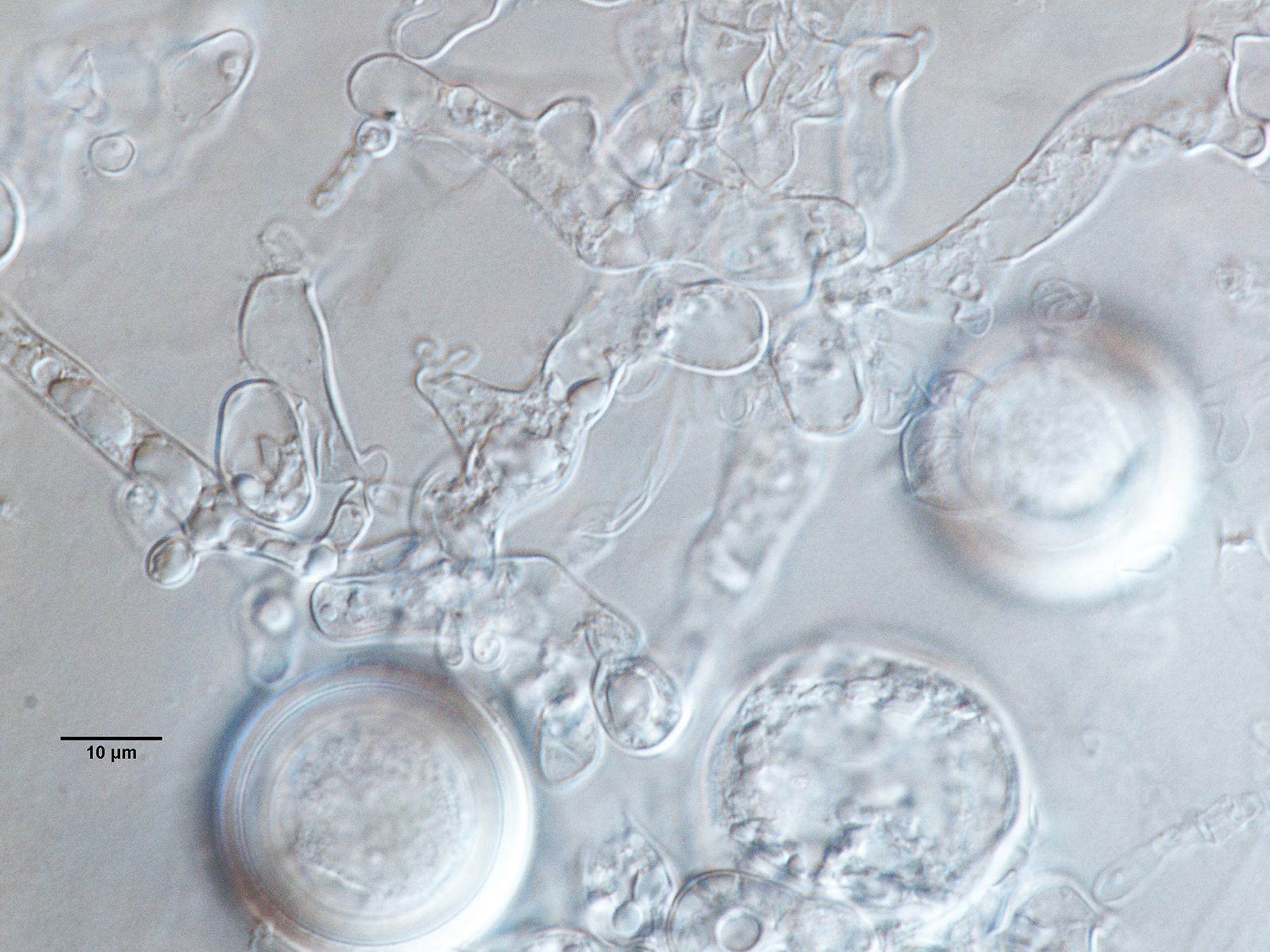Phytophthora foliorum
|
Phytophthora spp. in subclade 8c: portion of the seven-loci ML phylogeny featuring the type cultures of 212 described species (by T. Bourret). Notice the position of P. foliorum Ex-type CBS 121655 = S&T BL 168. Gloria Abad, USDA S&T.
|
|
Phytophthora spp. in subclade 8c: Morphological Tabular key (PDF) and Tabular key legends (PDF) in IDphy2 KEY SECTION. Notice the data of P. foliorum Ex-type CBS 121655 = S&T BL 168. Gloria Abad, USDA S&T.
|
|
Phytophthora foliorum (CPHST BL 168) colonies of a selected specimen grown for 7 days on (a) V8® Agar, (b) potato dextrose agar, and (c) malt extract agar; photo by Krysta Jennings and Leandra Knight, USDA-APHIS-PPQ |
|
Phytophthora foliorum (ex-type CPHST BL 168) homothallic sexual phase: (a–d) smooth-walled oogonia with paragynous antheridia and plerotic oospores; (d) oogonia with tapered bases and small paragynous antheridia; photos by Gloria Abad, USDA-APHIS-PPQ. |
|
Phytophthora foliorum (Ph168 selected specimen) homothallic sexual phase: (a, b, e) hyphal swellings and oospores; (b–e) smooth-walled oogonia with paragynous antheridia and plerotic oospores; (c) oogonia with tapered bases and small paragynous antheridia; (d) amphigynous antheridia; photos by Gloria Abad, USDA-APHIS-PPQ. |
|
Phytophthora foliorum (Ph168 selected specimen) typical hyphal swellings; photos by Gloria Abad, USDA-APHIS-PPQ |
|
Phytophthora foliorum (ex-type CPHST BL 168) homothallic sexual phase: oogonia with tapered bases and small paragynous antheridia; photo by Gloria Abad, USDA-APHIS-PPQ. |
|
Phytophthora foliorum (ex-type CPHST BL 168) homothallic sexual phase: smooth-walled oogonium with paragynous antheridium and plerotic oospore; photo by Gloria Abad, USDA-APHIS-PPQ. |
|
Phytophthora foliorum (ex-type CPHST BL 168) homothallic sexual phase: smooth-walled oogonia with paragynous antheridia and plerotic oospores; photo by Gloria Abad, USDA-APHIS-PPQ. |
|
Phytophthora foliorum (ex-type CPHST BL 168) homothallic sexual phase: oospores and hyphal swellings; photo by Gloria Abad, USDA-APHIS-PPQ. |
|
Phytophthora foliorum (ex-type CPHST BL 168) homothallic sexual phase: smooth-walled oogonia with paragynous antheridia and plerotic oospores; photo by Gloria Abad, USDA-APHIS-PPQ. |
|
Phytophthora foliorum (ex-type CPHST BL 168) homothallic sexual phase: oogonia with tapered bases and small paragynous antheridia; photo by Gloria Abad, USDA-APHIS-PPQ. |
|
Phytophthora foliorum (ex-type CPHST BL 168) homothallic sexual phase: oogonia with tapered bases and small paragynous antheridia; photo by Gloria Abad, USDA-APHIS-PPQ. |
|
Phytophthora foliorum (ex-type CPHST BL 168) homothallic sexual phase: oogonia with tapered bases and small paragynous antheridia, and hyphal swellings; photo by Gloria Abad, USDA-APHIS-PPQ. |
Name and publication
Phytophthora foliorum Donahoo & Lamour (2006)
Donahoo R, Blomquist CL, Thomas SL, Moulton JK, Cooke DEL, and Lamour KH. 2006. Phytophthora foliorum sp. nov., a new species causing leaf blight of azalea. Mycol. Res. 110: 1309–1322 (pg. 1318).
Corresponding author: klamour@utk.edu
Nomenclature
from Donahoo et al. (2006)
Mycobank
Etymology
refers to pathogenicity on leaves
Typification
Type: UNITED STATES OF AMERICA collected from Azalea ‘Pink Ruffles’ in nursery, in Tennessee, May 2004, K. Lamour 192, isol. ATCC MYA-3638
Ex-type: ATCC MYA-3638
Ex-type in other collections
(ET) CBS 121655, ATCC MYA-3638, CMW 31064, WPC P10969, LT192 Lamour, S&T BL 168 (Abad), 49J8 (Hong)
Molecular identification
Voucher sequences for barcoding genes (ITS rDNA and COI) of the ex-type (see Molecular protocols page)
Phytophthora foliorum isolate CPHST BL 38G (= P10974 WPC) = ITS rDNA MG865492, COI MH136888
Sequences for selected specimen
Phytophthora foliorum isolate CPHST BL 168 (= P10969 WPC) = ITS rDNA MG865493, COI MH136889
Voucher sequences for Molecular Toolbox with seven genes (ITS, β-tub, COI, EF1α, HSP90, L10, and YPT1
(see Molecular protocols page) (In Progress)
Voucher sequences for Metabarcoding High-throughput Sequencing (HTS) Technologies [Molecular Operational Taxonomic Unit (MOTU)]
(see Molecular protocols page) (In Progress)
Sequences with multiple genes for ex-type in other sources
- NCBI: Phytophthora foliorum CPHST BL 38G
- NCBI: Phytophthora foliorum P10974
- NCBI: Phytophthora foliorum LT192
- NCBI: Phytophthora foliorum Lamour
- EPPO-Q-bank: Phytophthora foliorum CBS 121655
- BOLDSYSTEMS: Phytophthora foliorum (barcoding COI & ITS)
Position in multigenic phylogeny with 7 genes (ITS, β-tub, COI, EF1α, HSP90, L10, and YPT1)
Clade clade:
a taxonomic group of organisms classified together on the basis of homologous features traced to a common ancestor
8c
Morphological identification
adapted from Donahoo et al. (2006)
Colonies and cardinal temperatures
Colony colony:
assemblage of hyphae which usually develops form a single source and grows in a coordinated way
morphology after 7 days on V8-A, PDA, and MEA with slight chrysanthemum pattern. Minimum growth temperature 2°C, optimum 25°C, and maximum 30°C.
Conditions for growth and sporulation
Sporangia, hyphal swellings, and chlamydosporeschlamydospores:
an asexual spore with a thickened inner wall that is delimited from the mycelium by a septum; may be terminal or intercalary, and survives for long periods in soil
produced in soil extract water; oosporesoospores:
zygote or thick-walled spore that forms within the oogonium after fertilization by the antheridium; may be long-lived
abundantly produced in culture.
Asexual phase
SporangiaSporangia:
sac within which zoospores form, especially when water is cooled to about 10°C below ambient temperature; in solid substrates, sporangia usually germinate by germ tubes
nonpapillatenonpapillate:
pertaining to the production of a non-distinct, or inconspicuous, papilla at the distal end of the sporangium (cf. papillate and semipapillate)
, occasionally semipapillatesemipapillate:
pertaining to the production of shallow having papilla that are not well developed, shallow and less nipple-like than fully papillate structures
; persistentpersistent:
pertaining to sporangia that remain attached to the sporangiophore and do not separate or detach easily (cf. caducous)
; ovoidovoid:
egg-shaped, with the widest part at the base of the sporangium and the narrow part at the apex
, obpyriformobpyriform:
inversely pear-shaped, i.e. with the widest part at the point of attachment (cf. pyriform)
, obovoidobovoid:
inversely egg-shaped; ovoid, but with the widest part at the apex
, and distorted shapes (29–69 L X 19–42 W µm); showing internal proliferationinternal proliferation:
internal proliferation occurs when the sporangiophore continues to grow through an empty sporangium
, occasionally with nested proliferationnested proliferation:
a type of internal proliferation where a new sporangium develops successively inside the old sporangium after it has emptied
; originated in long unbranched or simple sympodial sporangiophores. Hyphal swellings with short, irregular, knob-like protuberances. ChlamydosporesChlamydospores:
an asexual spore with a thickened inner wall that is delimited from the mycelium by a septum; may be terminal or intercalary, and survives for long periods in soil
are globoseglobose:
having a rounded form resembling that of a sphere
, sub-globose (16-51 µm diam), lateral, terminal, and intercalaryintercalary:
positioned within a hypha (cf. terminal)
.
NOTE: SporangiaSporangia:
sac within which zoospores form, especially when water is cooled to about 10°C below ambient temperature; in solid substrates, sporangia usually germinate by germ tubes
were originally described as semipapillatesemipapillate:
pertaining to the production of shallow having papilla that are not well developed, shallow and less nipple-like than fully papillate structures
and caducouscaducous:
pertaining to sporangia that become dislodged readily (i.e. deciduous) and separate from the sporangiophore (cf. persistent)
with short pedicelpedicel:
the hyphal base of a sporangium that remains attached after the sporangium separates, or is shed, from the sporangiophore; the pedicel may be short (< 5 µm), medium (5–20 µm), or long (> 20 µm)
(<5–20 µm), and no chlamydosporeschlamydospores:
an asexual spore with a thickened inner wall that is delimited from the mycelium by a septum; may be terminal or intercalary, and survives for long periods in soil
or hyphal swellings are described by Donahoo et al. (2006).
Sexual phase
Homothallichomothallic:
pertaining to sexual reproduction that can take place within a single thallus (i.e. self-fertile, non-outcrossing) (cf. heterothallic).
. OogoniaOogonia:
the female gametangium in which the oospore forms after fertilization by the antheridium
smooth-walled (34–43 µm diam), some with tapered basetapered base:
pertaining to the base of a sporangium or oogonium; funnel-shaped
; antheridia mostly paragynousparagynous:
pertaining to the sexual stage in which the antheridium is attached to the side of the oogonium (cf. amphigynous)
(9–16 X 8–13 µm) showing some spines or digitate projections and usually attached to the oogoniaoogonia:
the female gametangium in which the oospore forms after fertilization by the antheridium
next to the oogonial stalk; oosporesoospores:
zygote or thick-walled spore that forms within the oogonium after fertilization by the antheridium; may be long-lived
pleroticplerotic:
pertaining to an oospore that fills the oogonium (cf. aplerotic)
, apleroticaplerotic:
pertaining to a mature oospore that does not fill the oogonium; i.e. there is room left between the oospore wall and oogonium wall (cf. plerotic)
, or slightly apleroticaplerotic:
pertaining to a mature oospore that does not fill the oogonium; i.e. there is room left between the oospore wall and oogonium wall (cf. plerotic)
(29–42 µm diam).
Most typical characters
Phytophthora foliorum is characterized by the very short irregular knob-like protuberances, very small antheridiaantheridia:
the male gametangium; a multinucleate, swollen hyphal tip affixed firmly to the wall of the female gametangium (the oogonium)
, and big chlamydosporeschlamydospores:
an asexual spore with a thickened inner wall that is delimited from the mycelium by a septum; may be terminal or intercalary, and survives for long periods in soil
.
Additional specimen(s) evaluated
Phytophthora foliorum ex-type CPHST BL 38G, duplicate of P10974 (World Phytophthora Collection), which is a duplicate of ex-type “192 Kurt Lamour”
Hosts and distribution
Distribution: North America (USA: CA, TN); reported and eradicated (?) in Europe (Scotland, Spain)
Substrate: leaves
Disease note: leaf spots
Host: Rhododendron spp. (Ericaceae)
Retrieved January 30, 2018 from U.S. National Fungus Collections Nomenclature Database.
Additional info:
Hosts: Azalea spp. on foliage
Additional references and links
- SMML USDA-ARS: Phytophthora foliorum
- EPPO Global Database: Phytophthora foliorum
- Forest Phytophthoras of the world: Phytophthora foliorum
- CABI Digital Library: Phytophthora foliorum
- Encyclopedia of Life (EOL): Phytophthora foliorum
- Index Fungorum (IF): Phytophthora foliorum
- Google All Phytophthora foliorum
- Google Images Phytophthora foliorum
- Google Scholar Phytophthora foliorum
Fact sheet author
Z. Gloria Abad, Ph.D., USDA-APHIS-PPQ-S&T Plant Pathogen Confirmatory Diagnostics Laboratory (PPCDL), United States of America.


